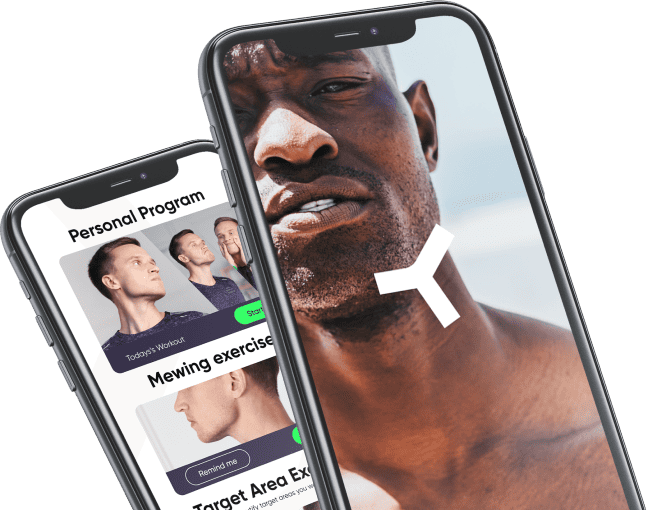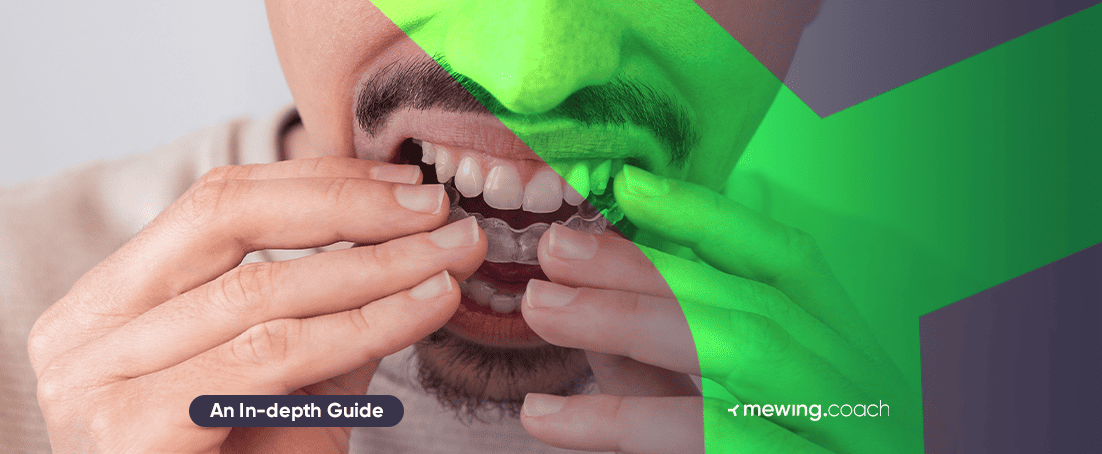
If you’ve recently had your braces removed, you can expect mewing to generally be a lot easier to practice. Yet, you’ll still be stuck with a pesky retainer that can get in the way and impact your technique.
Retainers help keep the teeth in place and are thus beneficial to your facial bones, just like mewing is good for your face and lower jaw. However, things might become a bit complicated when you attempt to implement both of these together.
Whether you’re new to this and wondering, “What is facial mewing?” or simply aren’t sure if you can practice the technique while wearing retainers, this article will provide you with all you need to know.
- 🔎 What’s in our comprehensive guide to mewing and retainers:
- 👉Purpose of the Retainers?
- ❓Mewing With Retainers: Is it Possible?
- 📌5 Tips for Mewing with Retainers
Let’s jump right in!
The Purpose of Retainers and Why You Should Wear Them
Misaligned teeth aren’t uncommon, and a lot of people turn to orthodontics to align their teeth properly and get a striking smile. Anyone who’s been in this position can tell you that although it seems like a big adjustment, you’ll quickly get used to braces, and mewing can still be easily implemented into your routine.
Now, once you remove your braces, you’ll go through yet another adjustment period – a significant one. Post-orthodontics, your teeth will be in a vulnerable position, and it’s crucial to take care of them well.
Your braces force your teeth into a new position by making them move around in the alveolar bone, the part of your skull that makes up the tooth sockets. Although this area has a very fast bone remodeling rate, especially compared to the rest of your body, it can still take over a year for the new position to solidify.
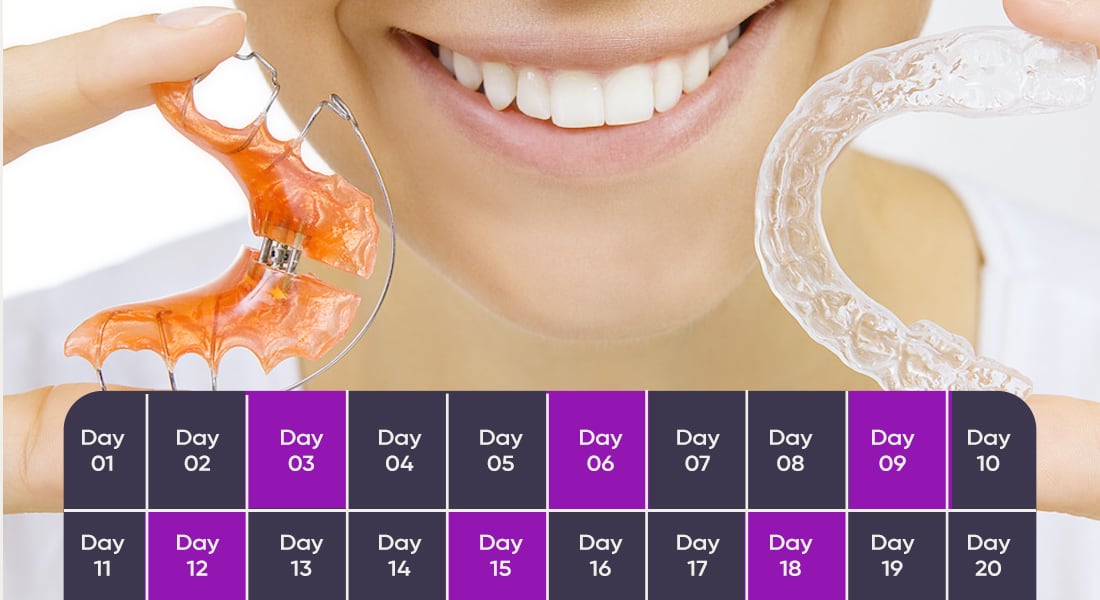
Your jaw will have small gaps until the area around your teeth hardens. This is nothing too large or significant, but enough space for your teeth to move around slightly. The bone must first be resorbed from one side and then placed from another to lock your teeth into their new location.
This is where retainers come in and precisely why they are so important – they ensure your teeth stay in their ideal position. Your retainer maintains the alignment of your teeth after orthodontics treatment and helps your teeth to lock into the correct place as the bone around them adjusts to the new positioning.
A model of your teeth is used to create a retainer that fits your teeth perfectly. After that, you will have to wear the device every night to prevent teeth from returning to their original position.
Mewing With Retainers: Is it Possible and Should You Do it?
The process of mewing requires you to situate your tongue on the roof of your mouth and adopt that position as the tongue’s natural resting spot. Dr. Mew introduced this method of enforcing proper tongue posture in the 1970s and later promoted it to the world, mainly with the help of social media.
Mewing is primarily about having the correct tongue position and has become popular as a way to achieve better-defined and well-structured facial features. However, mewing has a lot of other benefits as well, like improving facial symmetry, resolving breathing issues, and even aligning your teeth.
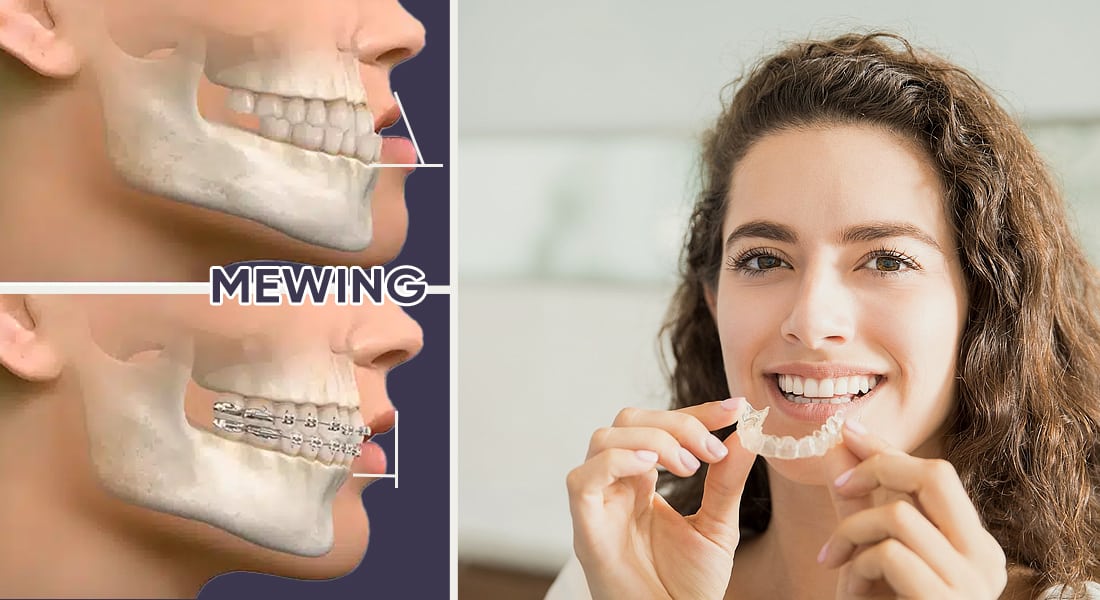
It’s obvious to see how braces and retainers can get in the way, impede tongue movement, and hurt the overall process. So, while orthodontics and mewing can work hand in hand to achieve great results, it certainly makes the process more complicated and challenging, especially if you want to try different types of mewing devices.
On top of this added difficulty, consider that perfecting your mewing technique will take time, even without any additional obstacles. Also, as we already mentioned, teeth are vulnerable post-braces, so you need to be extra cautious while mewing.
However, mewing is definitely possible and can work well in tandem with orthodontics – given it’s done properly and you mind your teeth positioning when mewing.
After you’ve found and started practicing mewing, do not carelessly and permanently take out your retainers. Even if you feel like a retainer prevents you from fully utilizing your tongue, you should follow your orthodontist’s instructions and try to work around this difficulty when mewing.
5 Tips for Mewing With Retainers
Typically, while you’re mewing during the day, you’re forcing your teeth forward to expand your palate and give you the face development necessary for your defined jaw. Meanwhile, the retainer does its best to move your teeth back at night. So, you will effectively see no impact, and your mewing is useless.
What’s more, this will cause your teeth to jiggle back and forth and affects more than just the alignment of your jaw. Doing this routinely can therefore have the complete opposite effects of what you want and damage your smile.
You should be focusing on using a proper and correct mewing method. While it may take a while to adjust, as long as you focus on using the correct technique, you can build a healthy mewing habit even while you have retainers.
Here are some reminders to keep in mind while you’re mewing with retainers:
- The goal is to lock your teeth in place, so avoid pushing on your front teeth;
- Create an upward force by ensuring that the entire tongue is lightly pressed against the roof of your mouth;
- Only gently push on your palate and avoid hard mewing.
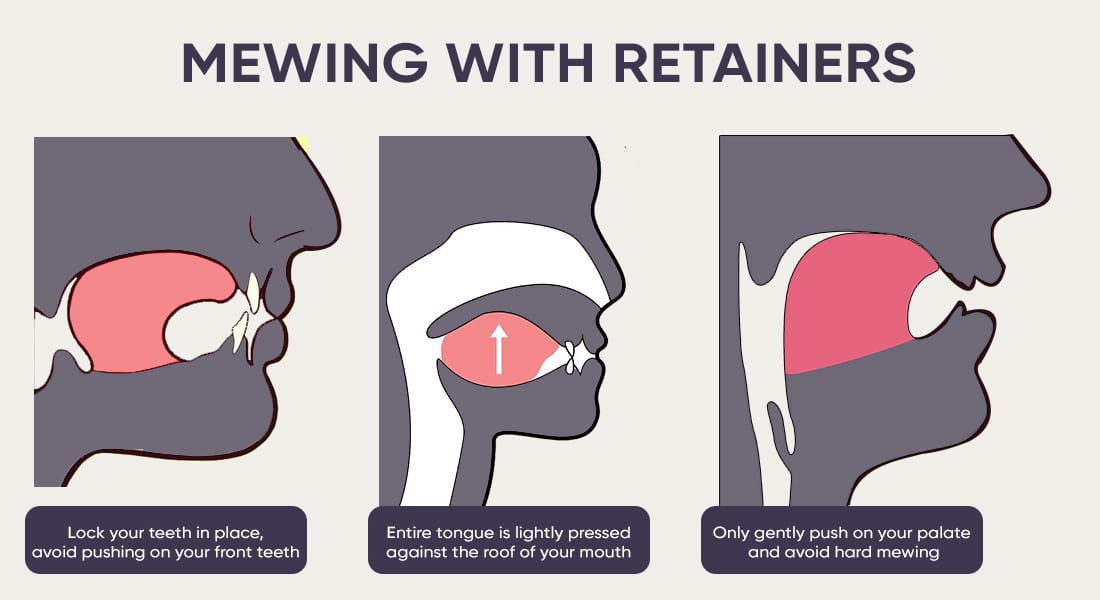
1 – Mewing With Invisalign
Invisalign is a transparent aligner that is used to straighten your teeth. It’s one of many aligners available but is regarded as one of the most prominent tools on the market since its clear and translucent nature makes it far more aesthetically pleasing than the alternatives.
Your Invisalign set is created using an impression of your teeth and molded to perfectly fit your mouth. Because this aligner only covers the teeth and leaves the rest of your mouth intact, Invisalign and mewing can go together with no trouble.
The aligner does not stretch to the roof of your mouth, so you should have no problem practicing proper tongue positioning. However, you still need to be careful not to disrupt your teeth or orthodontics. For the best posture, make sure your tongue reaches as close to your teeth as possible without touching the Invisalign.
Ultimately, Invisalign can be useful to your mewing technique, as you will be able to tell more easily when your tongue touches or presses on your teeth. If you notice this happening, change positioning and make sure you are pushing upwards and not disturbing your front teeth.
2 – Mewing with Essix Retainer
The Essix retainer is a clear plastic retainer and one of the most popular types on the market today. Similarly to Invisalign, people prefer this kind of device because of its subtle and transparent appearance that allows it to remain more unnoticeable when worn.
Although the Essix retainer may appear fragile, it does a great job of aligning your teeth into place. With proper maintenance, a set of Essix retainers should remain effective for as long as you need to use them.
Essix retainers can take a while to get used to, but they only cover your teeth, so they shouldn’t obstruct your tongue in the slightest. Because of this, they are simple to mew with and don’t cause many difficulties. You may mew as you usually would, remembering to avoid hard pushing on your palate and practicing the correct technique the whole time.
An Essix retainer will come between your tongue and your front teeth if you get too close. This should alert you to fix your positioning and move the tongue back.
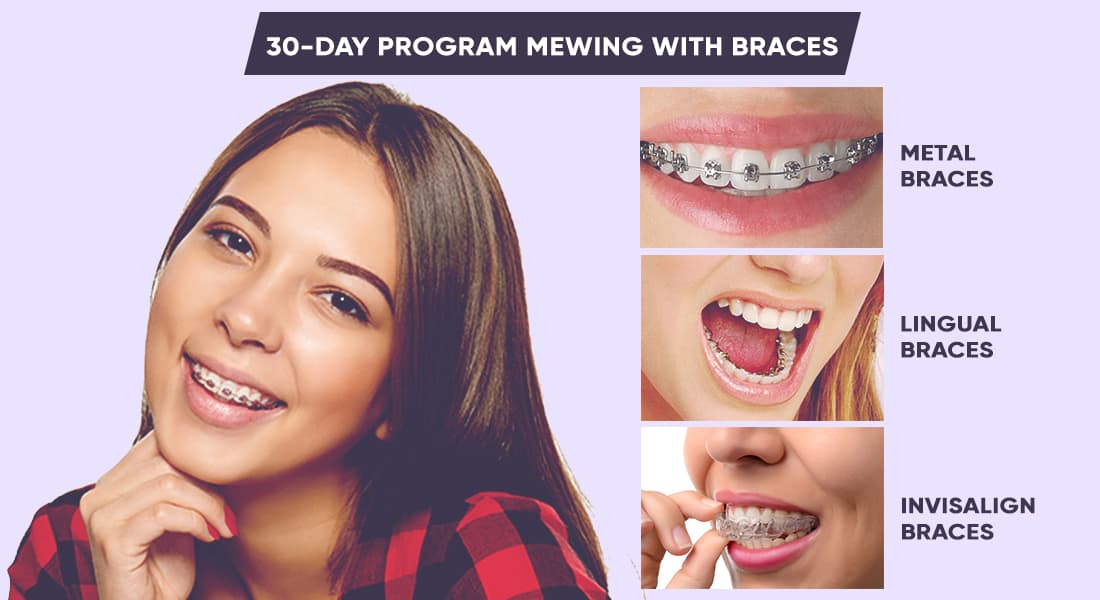
3 – Mewing with Hawley Retainer
Hawley retainers are another device commonly worn after braces are removed. This type of retainer is more traditional, with metal wires positioned outside of the teeth to improve alignment.
People may be recommended this retainer or choose to wear it for multiple reasons. One of the greatest features of a Hawley retainer is its durability, which, with regular maintenance, enables it to survive for years. These retainers can also be fixed if broken and adjusted down the line.
However, Hawley retainers can significantly impair one’s speech, especially in the early stages, which discourages individuals from purchasing them, even if they’re cheaper than plastic retainers. Additionally, the wire is far more visible to the bare eye and can irritate your lip and cheek.
Hawley retainers are also bad for mewing because they take up room on the upper palate where you need to place your tongue. This can make mewing with a Hawley retainer impossible, especially if you still need to wear the device throughout the day. If you only have to use your retainer at night, you can still feely mew during the day while, of course, minding your teeth and how much you push on your palate.
If you currently use a Hawley retainer, you can consider making another appointment with your orthodontist or dentist to request an Essix retained or a fixed retainer if you’d like to mew more easily.
4 – Mewing with Fixed Retainers
A fixed retainer is only used when a few of your teeth need to be locked in place and this device can’t be removed as Essix or Hawley retainers can. This retainer has many advantages, including the fact that it’s probably the easiest type to mew with.
The wire on fixed retainers is placed on the back of your teeth, so even though you need to wear the fixture 24/7, it remains concealed. These retainers are small, unimposing, and don’t take up a lot of room in your mouth.
A major disadvantage of a fixed retainer is that it’s difficult to clean. Since you can’t take out the retainer before eating, food can easily get stuck and create issues if you fail to remove it. Flossing can help, but it’s still advised that you avoid hard or sticky foods that can get caught in the retainer or damage the device.
However, when it comes to mewing, you should experience virtually no difficulty as a fixed retainer leave plenty of space in your mouth for your tongue to move around and lay in the correct position. Again, you should be careful not to push on your teeth, but if you’ve practiced proper oral posture for long enough, this should hardly be an issue.
5 – Mewing With Braces
You may practice mewing while wearing braces, although the extent to which you can mew and the level of possible discomfort will depend on the sort of braces you have.
It’s crucial to note that in cases of crowded, unevenly spaced, or crooked teeth, there is no research evidence as of yet to show that mewing can replace the benefits of braces or clear aligners. However, there are numerous testimonials that speak of the advantages of using a proper mewing process.

So, if you believe the technique will benefit you, you have nothing to worry about, as braces and mewing can go together. You can discuss this with your dentist the practice along with any prescribed orthodontic treatment.
It’s necessary to care about getting your teeth aligned properly, but it’s also crucial to consider facial aesthetics. Your jaw needs to be shaped in a way that complements the rest of your face. Among other things, mewing is an excellent approach to achieving a slimmer face with a highly desired sharp jawline.
Removing the Retainers for Mewing
Generally speaking, it is advised that you wear your retainer for a bit longer than you did your braces. However long that is, you should follow instructions given to you by a professional and wear the retainer for the full duration of your therapy.
Still, a lot of retainers are removable and may be taken out for various reasons. The longer you use your retainer, the likelier you’ll need to keep it in your mouth for less time during the day. You can occasionally remove your retainer to practice mewing.
However, if you remove your retainer to mew and asses your tongue positioning but you notice it’s tighter once you try it on again – put it back in. This is a sign that your teeth are probably relapsing.
If you’re using an Essix retainer, you can also practice your mewing while using the device. A proper mewing technique can be an invaluable tool to use on top of orthodontic treatment and to prevent relapse.
Mewing can also ensure your teeth don’t relapse to their old position once the retainer is removed. However, keep in mind that relapse prevention is only as successful as your approach, and you must always maintain the correct tongue posture.
Final Thoughts on Mewing with Retainers
Mewing has been shown to have many advantages by several testimonies, and you may want to see it for yourself. Well, following this article, you should see that anyone can try this DIY technique and see some very useful results.
Yet, if you are considering mewing with retainers for the first time, it could be a bit challenging. You will find that practicing it gets easier once you do get the hang of it, but remember, you must always be cautious about how you approach it.
There is no definite evidence that oral and face exercises of any sort can take the place of orthodontic treatment, however, they may be able to relieve some dental problems and be an effective addition to your retainment treatment.
You can start your journey today with Mewing.coach! This app will train and improve your jaw, facial muscles, and overall appearance to the desired result. Take the quiz and start your personal mewing technique today!




